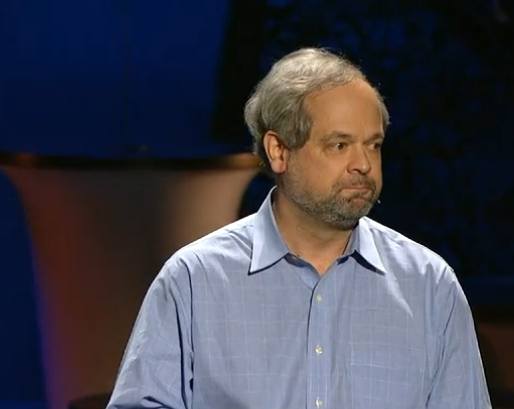Now, right behind the financial crisis there's a second and bigger wave that we need to talk about.
現在,在金融危機背后的是第二波更大的浪潮,這是我們需要講的。
That wave is much larger, much more powerful, and that's of course the wave of technology.
這股浪潮要大的多,也有力的多,當然這是技術的浪潮。
And what's really important in this stuff is, as we cut, we also have to grow.
在這里面最重要的是,當我們在削減的同時,也需要增長。
Among other things, because startup companies are .02 percent of U.S. GDP investmentm and they're about 17.8 percent of output.
不說別的,就只說新晉的公司,只占美國GDP的投資的0.02%,卻帶來了17.8%的產出。
It's groups like that in this room that generate the future of the U.S. economy.
這樣的一群人,比如在這個房間內的各位便是創造美國經濟未來的人。
And that's what we've got to keep growing. We don't have to keep growing these bridges to nowhere.
這是我們需要保持增長的部分。我們不必毫無方向地發展。
So let's bring a romance novelist into this conversation. And that's where these three trends come together.
因此讓我們把浪漫派作家帶進這場談話中。這是三個趨勢合并到一起的地方。
That's where the ability to engineer microbes, the ability to engineer tissues, and the ability to engineer robots begin to lead to a reboot.
便是微生物工程、組織工程、機器人工程所導向的復蘇。
And let me recap some of the stuff you've seen.
讓我重述一些你們所見過的東西。
Craig Venter showed up last year and showed you the first fully programmable cell that acts like hardware where you can insert DNA and have it boot up as a different species.
克雷格凡特去年來到這里,并展示給大家第一個完全可編程的,運行起來就像計算機硬件般的細胞,你能植入DNA,并且啟動它,變成另一個物種。
In parallel, the folks at MIT have been building a standard registry of biological parts.
與此同時,在MIT的人們開始制定生物器官的標準注冊表。
So think of it as a Radio Shack for biology. You can go out and get your proteins, your RNA, your DNA, whatever.
可以把這些想像成一股生物界的震蕩波。你可以獲得你的蛋白質,RNA,DNA,或者任何東西。

And start building stuff. In 2006 they brought together high school students and college students and started to build these little odd creatures.
并開始制造東西。在2006年他們組織了一些高中生和大學生開始制造這些奇怪的小東西。
They just happened to be alive instead of circuit boards.
它們的確活了起來而不只是電路板。
Here was one of the first things they built. So, cells have this cycle.
這是它們制造的第一個東西,細胞有這樣的一個周期。
First they don't grow. Then they grow exponentially. Then they stop growing.
起先它們不生長,接著以指數速度生長,然后又停止。
Graduate students wanted a way of telling which stage they were in.
研究生們希望找到一種方法能知道他們是處在什么階段。
So they engineered these cells so that when they're growing in the exponential phase, they would smell like wintergreen.
所以他們改造了這些細胞,這樣這些細胞就能在指數增長階段時,散發除鹿蹄草的味道,當它們停止生長就會聞起來像香蕉。
And when they stopped growing they would smell like bananas. And you could tell very easily when your experiment was working and wasn't, and where it was in the phase.
這樣你就能很方便地知道你的實驗什么時候是順利的,什么時候不起作用,以及它正處在什么階段。











